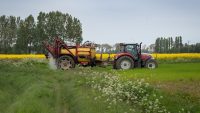Wheat is one of the most widely cultivated cereal grains in the world and a staple food for a significant portion of the global population. Belonging to the Triticum genus, wheat is a grass cultivated for its nutritious seeds, which are commonly ground into flour and used to make bread, pasta, pastries, and a variety of other food products. Wheat is cultivated on every continent except Antarctica and is grown in diverse climates, from temperate regions to semi-arid and arid environments.
There are several different species of wheat, with the most commonly cultivated being common wheat ( Triticum aestivum ), also known as bread wheat. Other important species include durum wheat (Triticum turgidum), used primarily for making pasta, and spelt wheat (Triticum spelta), an ancient grain with a nutty flavor and high nutritional value. Wheat varieties also vary in terms of their gluten content, which affects their suitability for baking and food processing.
Wheat plays a crucial role in global food security, providing a significant source of calories, protein, and essential nutrients for billions of people worldwide. It is a versatile crop that can be used in a wide range of food products and is an important ingredient in many traditional cuisines around the world. However, wheat cultivation also presents challenges, including susceptibility to pests and diseases, the need for intensive irrigation and fertilization in some regions, and concerns about environmental sustainability. As the world’s population continues to grow, ensuring the availability and sustainability of wheat production will be essential for meeting the dietary needs of a growing population while minimizing the environmental impact of agriculture.

Let’s take a look at these 10 interesting facts about wheat to know more about it.
- One of the Oldest Cultivated Crops : Wheat has been cultivated by humans for thousands of years, with evidence of its cultivation dating back to around 10,000 BCE in the Fertile Crescent of the Middle East, an area known as the cradle of civilization.
- Most Widely Grown Crop : Wheat is the most widely grown crop in the world, occupying more land area than any other crop. It is cultivated on approximately 220 million hectares of land globally, contributing significantly to global food security.
- Versatile Grain : Wheat is a highly versatile grain that can be processed into various food products, including bread, pasta, noodles, couscous, bulgur, and breakfast cereals. It is also used as animal feed and in the production of biofuels and alcoholic beverages.
- Different Types of Wheat : There are several different species of wheat, each with unique characteristics and culinary uses. Common wheat (Triticum aestivum) is the most widely cultivated species and is used primarily for making bread. Durum wheat (Triticum turgidum) is known for its high protein content and is used mainly in pasta production.
- Gluten Content : Wheat contains gluten, a protein that gives dough its elasticity and helps it rise during baking. Gluten is responsible for the chewy texture of bread and the stretchiness of pizza dough. However, some people are intolerant or allergic to gluten, leading to conditions such as celiac disease or non-celiac gluten sensitivity.
- Nutritional Benefits : Wheat is a good source of carbohydrates, protein, fiber, vitamins, and minerals. Whole wheat products, in particular, are rich in dietary fiber, which promotes digestive health and may help reduce the risk of chronic diseases such as heart disease and type 2 diabetes.
- High-Yielding Crop : Wheat is known for its high yield potential, with modern varieties capable of producing large quantities of grain per hectare. Advances in breeding and agronomic practices have significantly increased wheat yields over the past century, contributing to food security and economic development.
- Crop Rotation : Wheat is often grown in rotation with other crops, such as corn, soybeans, or legumes, as part of sustainable agricultural practices. Crop rotation helps improve soil health, control pests and diseases, and optimize nutrient use efficiency.
- Harvesting Methods : Wheat is typically harvested using mechanical combines, machines that cut, thresh, and clean the grain in a single operation. Harvesting usually takes place in the late spring or early summer, depending on the region and variety of wheat being grown.
- Cultural Significance : Wheat has cultural significance in many societies around the world and is associated with rituals, traditions, and celebrations. In some cultures, wheat symbolizes fertility, abundance, and prosperity and is used in religious ceremonies and festivals.
Wheat stands as a cornerstone of human civilization, deeply intertwined with our history, culture, and culinary traditions. From its origins in the ancient Fertile Crescent to its widespread cultivation across the globe, wheat has played a vital role in sustaining populations and shaping societies for millennia. As the most widely grown crop in the world, wheat continues to be a staple food for billions of people, providing essential nutrients and sustenance.
However, wheat cultivation also presents challenges, from environmental sustainability to addressing dietary concerns such as gluten intolerance. As we navigate the complexities of modern agriculture and strive to meet the needs of a growing population, the importance of wheat as a source of food security and cultural heritage remains undeniable. With ongoing research, innovation, and sustainable practices, we can ensure the continued availability and resilience of wheat production for generations to come.



